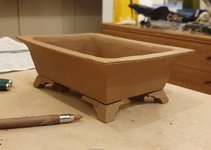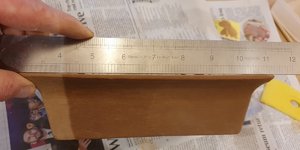I didn't want to download this PDF, cuz it's a PDF and I hate downloading PDF, mostly because I had so little space on my device the other day, I couldn't even delete stuff. Yeah, couldn't even delete stuff! Lol
I'd make a list of everything below 2% absorbtion, then dive into those to read their seperate charts like the one you found for this clay, to make sure which are good at the actual recommended temperature.
Drying cont'd....
I don't use clays that need to be bagged, a personal preference, but my argument is it's a waste of anyone's time. In studying process to understand how it aids on not needing to "slow dry" (which should be read as EVEN dry because slow only facilitates even, if even could be done in one second it would work just as well) there are a couple things I came up with.
I think it is important to understand this most, and why I believe you ought'nt dry them upside down.
Because of the natural outward taper when right side up, and the tendency for them to dry from the top down, the larger parts are drying and shrinking to meet the smaller lower part.
Upsidedown, the smaller part dries first, and it shrinks making it even smaller than the larger part below, this backwards size differential introduces more stress.
Rectangle rectangle....because of drying shrink percentages....rectangles are the most difficult shape to get right.
Level 3 Blind spot if you will!
I have begun to attach long sides first as a rule.
This allows the last thing to be wet (in a way, not perfected yet) the shorter sides. That allows time for the longer sides to dry/shrink more first, which balances out the differential, which makes them warp less.
Because the shrink is the same %, the longer the long side, the more distance it shrinks than the short side. This is the differential we should seek to offset.
It's not perfect yet, but every part of my method is utilizing every bit of physics to make for no cracks in or warps. There are so few things to correct for, I find it foolish to bag stuff, or attempt to dry them slow or even, because it just introduces more risk than finding the way to correct the few things that go wrong allowing them to dry in the open. Which can usually be tracked down to just a bit too much water attaching feet or walls.
Once bagged or otherwise "slowed", depending on the water movement through the specific body of course, a wall that was already dry and shrunk, will begin to expand again as it redistributes water through the piece. This is stress akin to bending metal over and over again, every redistribution makes the pot weaker, even if it never shows.
With this pot shape of yours, I think simply setting a piece of wax paper on top or otherwise slowing the rim just a bit, will allow you regular out in the open drying where all physics work in your favor. It should even the dry of the rim and the thickest bead part, then dry down the rest of the way fine.
Sorce





